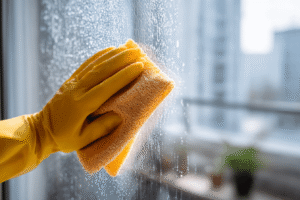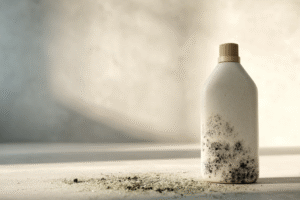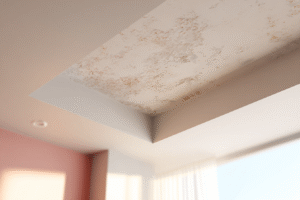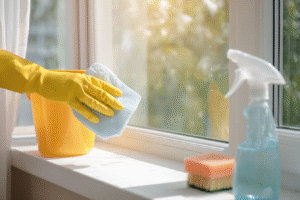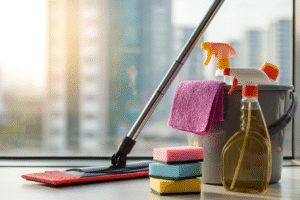Summarise this article with:
There’s nothing quite like the fresh scent of clean laundry… until your washing machine starts smelling like damp socks. If your washer has developed an unpleasant odour, don’t worry—we’ve got your back! In this guide, Wecasa expert house cleaners will show you exactly how to clean a smelly washer and bring back that fresh, just-washed feeling to your laundry. Whether you’re using a front-load or top-load machine, our easy tips and natural solutions will help you tackle all those nasty smells at the source.

Why Does Your Washing Machine Smell Stink?
You’d think that something designed to clean your clothes would stay fresh on its own, right? Unfortunately, washing machines are the perfect breeding ground for bacteria, mould and mildew.
Common Causes of Washing Machine Odours
- Detergent buildup: Too much soap or non-HE detergent leaves behind residue.
- Mould and mildew: Moisture trapped in seals, gaskets and drawers can grow mould.
- Clogged filters or drains: Blocked areas lead to stagnant water and bacteria.
- Low temperature washes: Cold washes don’t kill bacteria or dissolve detergent properly.
Different Types of Smells and Their Sources
Let’s break down those suspicious smells:
Musty and Mildew Smells
- Caused by moisture left in the drum or door seal.
- Often due to keeping the door closed between washes.
Sewage-Like Odors
- A blocked drain or backed-up waste pipe is likely the culprit.
- Smells can backtrack into the machine from the plumbing.
Rotten Egg Smell
- Often linked to sulphur-producing bacteria in standing water.
- Check hoses, filters and drum for hidden grime.
Damp Smell in Clothes
- Clothes smell musty even after a wash?
- That’s a sign your washer isn’t cleaning effectively—time for a deep clean!
How to Clean a Smelly Front-Load Washer
Front-loaders are efficient but prone to odour issues due to their design. Here’s how to keep yours clean and fresh.
Cleaning the Rubber Seal and Gasket
The rubber seal around your washing machine door is a common spot for mould and grime. To clean your machine’s seal and gasket, gently pull back the rubber and wipe inside using a cloth soaked in white vinegar or a vinegar-water mix. For stubborn spots, scrub with a toothbrush and a bit of baking soda paste. Finish by drying the area thoroughly with a clean towel.
Dealing with Detergent Drawer Buildup
Detergent drawers often collect soap scum and residue. To clean your washing machine’s drawer, carefully remove the drawer out and soak it in hot soapy water or vinegar. Scrub all areas with an old toothbrush, then rinse thoroughly and let it dry before putting it back.
Deep Cleaning the Washing Machine Drum
To keep your washing machine fresh and buildup-free, it’s a good idea to deep clean the machine’s drum once a month. Start by pouring 2 cups of white vinegar directly into the drum to break down limescale and kill bacteria. Add ½ cup of baking soda to the detergent drawer—this helps neutralise odours and lift residue. Run the machine on the hottest, longest cycle. Once the cycle is complete, wipe down the inside of the drum and door seal with a clean, dry cloth to remove any loosened grime and moisture.
Addressing Filter Blockages
Clogged filters can create smelly backups.
- Locate and remove the filter (check your user manual).
- Drain any excess water into a shallow dish.
- Rinse the filter under running water and scrub if needed.
- Reinsert and secure the cover.
How to get rid of bad smells from your top-load washing machine
To give your top-load washer a proper deep clean, start with a service wash. Select the hottest, longest cycle and pour 4 cups of white vinegar directly into the drum to break down grime and neutralise odours. After this cycle, run a second rinse with 1 cup of baking soda to freshen and deodorise the interior.
While the washer is running, remove the detergent and softener dispensers, soak them in hot water, and scrub thoroughly with an old toothbrush.
Once the cycle is complete, use a vinegar solution to wipe down the entire inside of the drum, including tricky spots under the lid and around the rim. For extra sanitation, add 1 cup of bleach and run another hot cycle without clothes, then finish with a plain water rinse to clear out any bleach residue.
Cleaning a Smelly Washing Machine Drain
Cleaning your washing machine drain is essential when you’re dealing with stubborn odours or slow draining.
- Start by unplugging your machine to ensure safety.
- Locate the drain hose, typically found at the back of the appliance. Place a shallow bucket or tray underneath to catch any trapped water before gently disconnecting the hose. Allow all the water to drain out fully.
- Next, flush the hose thoroughly using a mix of hot water and white vinegar—this helps dissolve any buildup of detergent residue, lint, or bacteria.
- For a deeper cleaning, you can also use a flexible brush or pipe cleaner to scrub inside the hose.
- Once clean, securely reconnect the hose, making sure there are no kinks or leaks, and run a short rinse cycle to clear out any remaining solution.
This quick maintenance step can significantly reduce foul smells and keep your machine running smoothly.
Tackling Specific Washing Machine Problems
Sometimes a quick wipe isn’t enough. Here’s how to deal with common washer woes.
Removing Mold and Mildew
- Use a bleach spray for severe cases.
- Let it sit for 10 minutes, then scrub and rinse.
- Don’t forget to air dry your machine afterwards!
Dealing with Bacteria Buildup
- Use enzyme-based cleaners monthly.
- Keep the door open after washes to let air circulate.
Cleaning Stubborn Stains
- For rust or hard water stains, use a lemon juice and vinegar mix.
- Apply with a sponge, leave to sit, then rinse thoroughly.
FAQs About Smelly Washing Machines
How often should you clean your washing machine?
The frequency of cleaning depends on your household’s laundry habits. Heavy users washing multiple loads daily should perform a maintenance clean every two weeks, while those doing 3-5 loads weekly can schedule monthly cleanings.
Make these quick habits part of your wash day routine: wipe the door seal after the final load and leave the door ajar to promote airflow. These simple steps between deep cleanings help maintain freshness and extend the time between thorough maintenance sessions.
What’s the best cleaning product for my washer?
White vinegar and baking soda are your go-to naturals. For more power, enzyme-based washer cleaners do wonders.
How can I prevent my washer from smelling?
- Leave the door open after use.
- Use the right amount of detergent.
- Run regular hot washes.
- Clean seals and drawers monthly.
When to Seek Professional Help
Tried everything and still dealing with a stinky situation? It might be time to call in the pros. If you notice:
- Persistent smells despite cleaning
- Leaks or drainage issues
- Electrical or mechanical faults
With a little care, your washing machine will stay odour-free, your laundry will smell lovely, and you’ll never have to hold your nose again.
Feeling overwhelmed by house chores? Let Wecasa take the stress away!Our professional cleaners are ready to step in and give your home the care it deserves. Simply book your cleaning session in a few clicks—then sit back, relax, and enjoy the sparkling results. A clean, calm space is just around the corner!




